13 Things We Won’t Forget About MUTEK 2013
Simply put, MUTEK 2013 was a pleasure to attend. The Montreal festival was in its […]
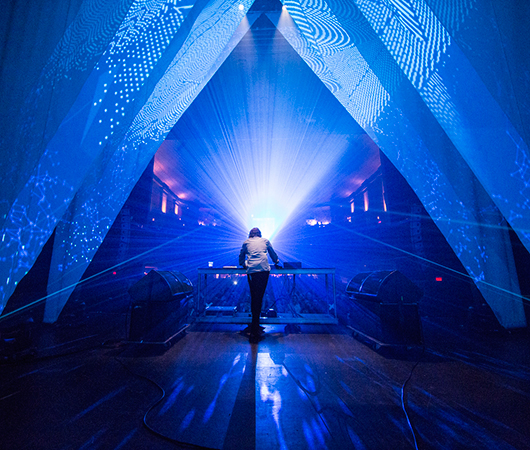
13 Things We Won’t Forget About MUTEK 2013
Simply put, MUTEK 2013 was a pleasure to attend. The Montreal festival was in its […]

Simply put, MUTEK 2013 was a pleasure to attend. The Montreal festival was in its 14th year, and although we didn’t arrive until the second day of the festivities, MUTEK proved once again that it’s more or less the standard bearer for how to put together—and execute—and high-quality event. Of course, being in Montreal and taking place during the first days of summer certainly helps, as few places feel more glorious, welcoming, and, yes, downright adorable when the sun is shining, but MUTEK is so much more than that. This year in particular, the line-ups were strong, the hiccups were inconsequential, the sound and visuals were top-notch, the crowds were enthusiastic and intelligent—a rare combination in the modern festival landscape—and the performances were… well, many of them were downright sublime. In short, there was a lot to love about this year’s MUTEK, but a few things really put it over the top.
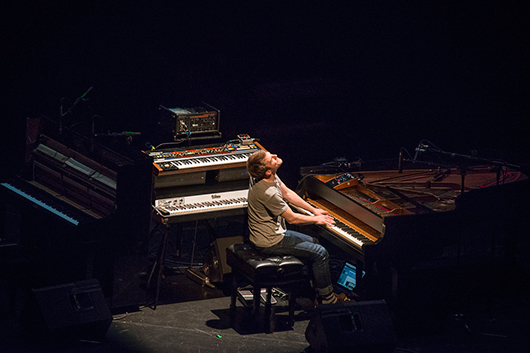
Nils Frahm is absurdly talented.
German composer/producer Nils Frahm opened up Thursday’s installment of A/Visions (MUTEK’s audio-visual series) and absolutely floored the audience with his performace. Bouncing between three different set-ups (one with synths, the other two with more traditional pianos) and offering inventive takes on classical composition, Frahm’s set was an absolute stunner. Without question, the guy is a virtuoso, but there’s a real charm to his work, as the music transcends the limits of most classical piano fare. Although the show took place in a seated theater, it’s no stretch to say that there was a real electricity in the room, particularly when he augmented his playing with synth pulses and electronic loops. It’s not often that one sees a standing ovation at an electronic music festival, but Frahm received several over the course of the night.
Frahm actually had a busy week at MUTEK, as he also performed at a special edition of the Boiler Room on Sunday. Later that day, he played for a third time, opening up for Pantha du Prince & The Bell Laboratory at the Maison Symphonique. (Frahm was enlisted at the last minute after an unexpected cancellation by scheduled openers Bugge Wesseltoft and Henrik Schwarz.) If MUTEK gave out a “Most Valuable Player” award for 2013, it very likely would have gone to Frahm.
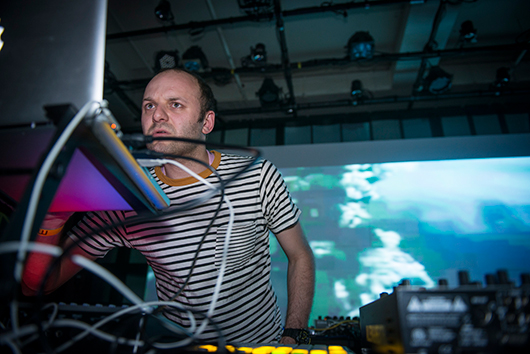
Andy Stott’s live show is a can’t-miss proposition at this point.
Over the past year, Andy Stott has been a fixture on the electronic festival circuit. His set at last year’s Decibel Festival was one of our favorites, and his Thursday night performance at MUTEK was similarly excellent. After opening with a harsh squall of dirge, the UK producer eventually moved into his dark and dubby comfort zone, piloting a journey through an assortment of chugging, slow-motion house and techno. While there was certainly a doom-and-gloom bent to Stott’s music, there was also a steady build to the proceedings, which climaxed in a bevy of classic hardcore breaks and riled the crowd at the Sociéte des Arts Technologiques (commonly referred to as the SAT) into a frenzy.
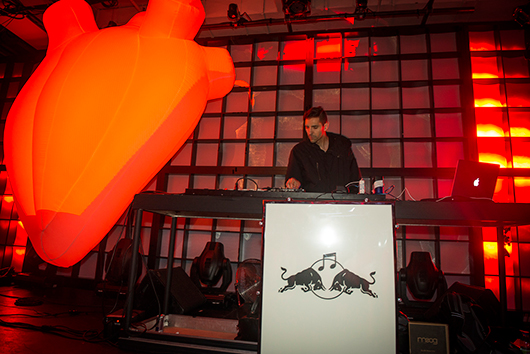
Martyn’s new live A/V show has a lot of heart. Literally.
Martyn has a new album slated to arrive in the fall, and he’s recently unveiled a new live A/V show to go along with the music. Both the LP and the show are titled The Air Between Your Words, and his headlining performance on Thursday night at the SAT marked only the third time he’d done the show for an audience. The visual aspect of the show was striking, as Martyn brought a giant, inflatable heart (modeled after a human heart, not a Valentine’s decoration) onstage, which was illuminated throughout the performance by a constantly morphing series of graphics and various visual elements. (The show was actually designed by Martyn and his 3024 partner Erosie, who does all of the label’s artwork.) As for the music, Martyn dropped a few staples, including “Masks,” “We Are You in the Future,” and the requisite flash of drum & bass toward the end of his set, but there were also a lot of new tracks, including several songs with a surprising amount of organic percussion sounds. Martyn has moved more towards proper house and techno in recent years, and his rhythmic sensibilities have become increasingly straight in the process, but much of his MUTEK set was marked by cycles of clattering drum patterns and a kinetic sense of motion, which actually served the music quite well.
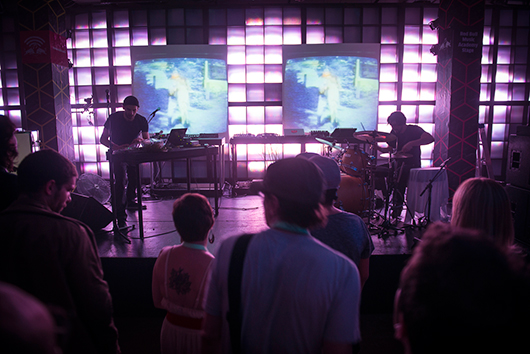
Ghislain Poirier’s new Boundary project is good… and hard to categorize.
On Friday night, Ghislain Poirier—who’s been operating for the past few years as simply Poirer—debuted his new Boundary project at the SAT. After years of turning out various permutations of bass-heavy electronics, dancehall, and soca, Poirier is exploring new ground with Boundary. However, explaining that ground is rather difficult, even after seeing the live set. Poirier took the stage with drummer Chris Olsen, and over the course of an hour, the two turned out a compelling session of percussion-heavy electronic sounds. At the same time, it wasn’t really straightforward dancefloor fare. One could detect elements of techno, but the music rarely settled into a steady 4/4 groove. The rhythms evolved and changed, the tempos shifted, and the show felt more like watching a band than settling into a dancefloor at a club. It’s tempting to reference terms like IDM or ambient when describing Boundary—and there were certainly parallels to ’90s-era Warp in the music—but the show was far more raw and visceral than that, especially with the live drums. At the same time, the duo also cooled things out occasionally and offered some introspective, even cinematic moments. In short, putting Boundary into any kind of neat box is just about impossible. Poirier isn’t following any trends or current movements; instead, he simply appears to be following his own artistic vision. So far, it appears to be working, even if the pundits—ourselves included—are left scratching their heads.
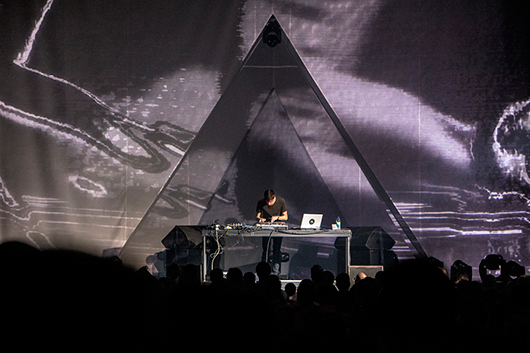
Jon Hopkins is about to blow up.
UK producer Jon Hopkins has been in the game for more than a decade, and though we’ve usually liked his music just fine—his 2009 Insides LP was particularly good—it appears that he’s finally made the proverbial leap and is about to assume a new level of prominence within the electronic sphere. Primarily known for his lush soundscapes and emotive melodies, Hopkins’ new album, Immunity, which drops this week, finds him successfully utilizing those elements within a techno template, and on Friday night at MUTEK, he brought this thunderous new sound to a packed house at Montreal’s massive Métropolis venue. Big is the best word to describe the music, as the beats boomed, the melodies were epic, and each track filled the sonic spectrum from top to bottom. Adding to the grandiosity of it all were the visuals, as Hopkins was stationed in front of a two-story series of white screens, each one with a progressively smaller triangular cut-out. Projected onto the screens was a constantly evolving mélange of geometric shapes and more abstract imagery, and the overall effect was truly stunning.
Hopkins’ show brought to mind the work of his Domino labelmate Four Tet—another artist whose once-delicate production aesthetic has shifted toward the dancefloor—though Hopkins has actually taken his music further into the club, ultimately offering something that for all its richness is actually much harder and more visceral. Comparisons aside, the show was impressive, and undoubtedly of of MUTEK 2013’s standouts.
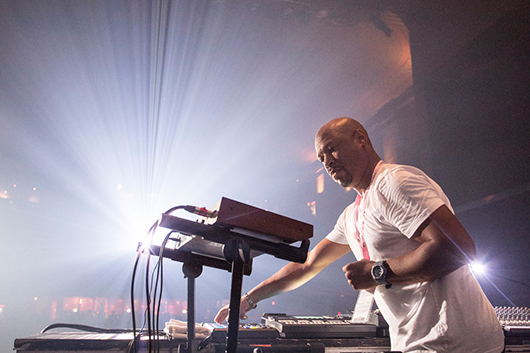
Robert Hood still does techno better than just about everyone.
Robert Hood was given the headlining slot on Friday at Métropolis, and even following the bombast of Jon Hopkins, the veteran producer went on stage and handled his business. Performing live, the Detroit veteran (who now lives in Alabama) didn’t offer much in the way of surprises, but that didn’t make the music any less compelling. After 20-plus years in the game, he’s going to do what he’s going to do, and he knows how to do it well. As such, hard techno was the order of the night, and watching Hood tap out drum patterns on his gear while his booming kicks rattled the floor was an absolute thrill. It was relentless, it was raw, it was Robert Hood. We certainly weren’t complaining.
Hood appeared again on Sunday evening, closing out the special MUTEK edition of the Boiler Room. Blending hard techno with some housier fare from his Floorplan project and a handful of vintage gems (Plastikman’s “Spastik” and New Order’s “Blue Monday were definitely played), it’s no exaggeration to say that Hood absolutely smashed it, stealing the show after an impressive afternoon of music.
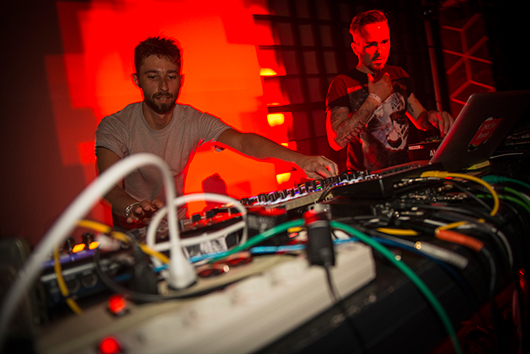
Graze just might be something special.
Anyone who’s been regularly reading XLR8R over the past few months has likely noticed that we’ve taken quite a liking to Graze, the new collaborative project from Adam Marshall and XI. Following the duo’s excellent self-titled EP (and our Bubblin’ Up profile), we were admittedly excited to witness the pair’s debut live show at MUTEK. Tasked with closing out the SAT on Friday night, Graze wasted no time in unfurling its percussion-heavy attack. Simply put, Graze is all about drums, and the vitality of its music lies in the duo’s ability to layer rhythmic patterns effectively. There wasn’t much in the way of melody, but the pair honestly didn’t really need it—the percussion alone had already ensnared the crowd. Given that, when the occasional synth flourish or rave throwback did find its way into the proceedings, the effect was particularly potent, and the energy level would noticeably jump. Clearly, it’s still early days for the Graze project, but Marshall and XI have certainly gotten off to a great start.
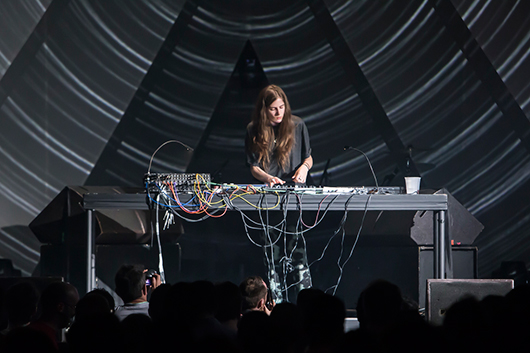
Laurel Halo is weird—in a great way.
XLR8R co-sponsored a showcase on Saturday night at Métropolis, and one of the early slots was given to Laurel Halo. Performing live with a small arsenal of gear, Halo’s set was entirely instrumental and loosely rooted in techno, though the rhythms and tempos were far too spastic (and at times abstract) to be neatly categorized. There was nothing very linear about her performance, yet that did nothing to detract from the music’s appeal. Much of the set brought to mind the work of artists like Shackleton, in that the tracks had a sort of organic vitality and were constantly morphing, changing, and shifting as Halo manipulated her rig. The tempos—and the energy level—rose and fell, but there was nonetheless a constant build, and by the end of her hour on the stage, Halo was banging it out in proper techno fashion, much to the delight of the dancefloor.
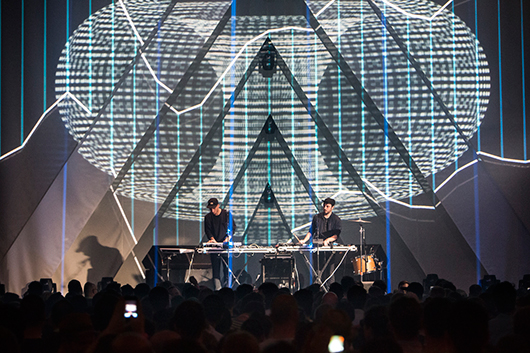
We have nothing bad to say about John Talabot.
We admit it. We love John Talabot. Not surprisingly, his show on Saturday night at MUTEK did nothing to change that fact. As always, Talabot took the stage alongside fellow Spaniard Pional; the duo has essentially spent the last year on the road, and that experience was readily apparent in its well-rehearsed live set. Though the sound was admittedly a bit off during the performance—it seemed to lack a bit of low-end heft—there was little else to take issue with during the hour-long session. The set was heavy on tracks from ƒIN, although many had been slightly tweaked and/or extended for a live setting. Songs like “Destiny” and “So Will Be Now…” obviously stood out, but the pair also slipped a couple of unreleased tracks into the set, including the infectious “I’ll Be Watching You,” a pop-tinged number that’s been a part of the Talabot live show for awhile now. The show ended with another live staple, a mash-up of sorts which combined Talabot’s debut 2009 single “Sunshine” with his piano-house-flavored remix of Teengirl Fantasy’s “Cheaters.” It was a joyous finale, and hammered home just how much potential Talabot and Pional have as they move into the future.
Deadbeat
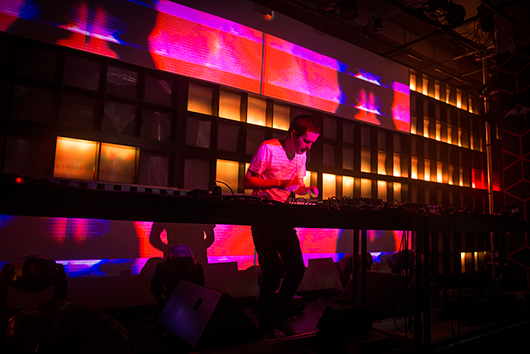
MUTEK understands the importance of the visual element.
At its core, MUTEK is an electronic music festival. However, its mission goes well beyond that, as festival organizers have always made a point to celebrate more than just the music. Technology is a big part of the MUTEK experience, as are the visual arts. As it happens, the two often go hand in hand at the festival, and 2013 was no different. On the whole, the MUTEK shows looked great. The A/Visions shows were impressive, but even the purely musical events at the SAT and Métropolis offered a stellar visual element. At these kinds of festivals, even the most ardent techno and electronic music fans can grow weary or find their attention drifting, particularly after absorbing hours of thudding rhythms, but MUTEK, as it always does, took extra care to break up the monotony with top-shelf lighting, visual projections, and stage design.
The festival updates the visual aesthetic of the SAT stage every year, but this year’s treatment was particularly good, with a large-scale lattice of colored light boxes covering the wall behind the stage. Looking not unlike an old-school disco dancefloor or even some of today’s flashier MIDI controllers, the grid was illuminated in an endless of geometric patterns, which enriched the overall experience. That said, the Métropolis definitely took the crown for the most impressive visuals, particularly once the giant screens were unveiled on Friday night. In tandem with an array of light beams that were installed all around (and above) the stage, a series of graphic projections offered a visual element that was both immersive and on par with the high quality of the music emanating from the stage.
Boiler Room in the SATosphere
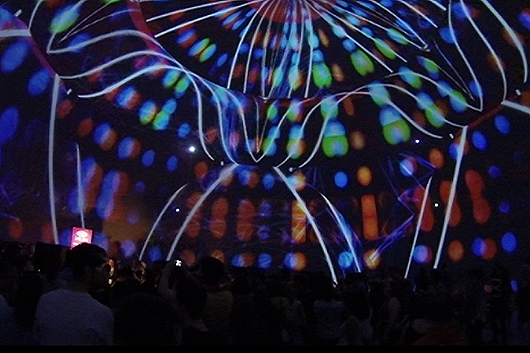
Missing Piknic was a bummer, but Boiler Room was fantastic.
Every year, the Sunday afternoon Piknic at MUTEK is one of the festival highlights. After nearly a week of shows inside clubs and theaters around the city, the chance to head out to Parc Jean-Drapeau and hear DJs in the open air while soaking up the summer sunshine is always a great way to wrap up the festivities. We’re guessing that Piknic offered more of the same this year—a closing set from John Talabot going back-to-back with Axel Boman sounded especially promising—but… we didn’t go.
That said, we had a very good reason. For the first time, Boiler Room came to MUTEK, and assembled a stellar line-up that included, Nils Frahm, Prison Garde, Boundary, Deadbeat, Onra, and Robert Hood. Even better, the whole thing took place the SATosphere, an incredible dome space on the top floor of the SAT that allows for enormous 360-degree projections. As such, the entire affair was breathtaking from a visual standpoint, and the quality tunes only added to the enjoyment. We’ve already mentioned the ace performances from Nils Frahm and Robert Hood at Boiler Room, but Boundary and Prison Garde (who composed a brand-new live set of synthy, vibey techno—which he said was inspired by Cold War radio transmissions—especially for the show) were also standouts. After hearing Robert Hood in particular, we left with no regrets about our decision to attend. That said, next year it would be nice if Piknic and Boiler Room were not happening simultaneously, as both were well worth checking out.
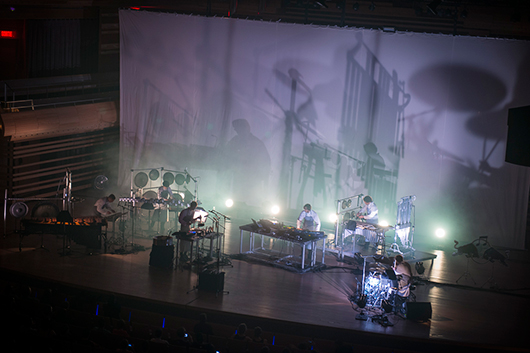
Pantha du Prince & the Bell Laboratory reaffirmed our faith in music.
This may sound like an exaggeration, but the Sunday evening performance from Pantha du Prince & The Bell Laboratory was only one of the best shows we’ve seen, well, ever. It was that good. Situated in Montreal’s pristine Maison Symphonique, the sound was absolutely perfect, something which became apparent as soon as the six-piece ensemble sauntered onstage—dressed in lab wear—while slowly ringing hand bells. What began as intermittent tones slowly coalesced into a hypnotic melody, after which the individual members assumed their various stations on stage. While Pantha du Prince himself appeared to be manning the electronic elements, the members of The Bell Laboratory (apart from the drummer) were all playing chime instruments—bells, xylophones, and even gongs were all part of the proceedings. True to the Elements of Light LP, the songs developed slowly, gradually building into gorgeously melodic pieces of techno. Although the Maison Symphonique is a seated venue, audience members couldn’t help themselves from getting up—some even darted into the aisles to start an impromptu dance party.
It’s difficult to communicate just how good the music sounded, but the acoustics of the room allowed the group’s array of chimes to sonorously float through the space. It was an ideal setting for Pantha du Prince to showcase his music, especially this project, as the music was rich, lush, and complex but also came across sounding light as air. As the show proceeded, the energy level in the room was buzzing, as it quickly became clear that we were all witnessing a very special event. MUTEK was full of wonderful performances and great music, but this show was on another level entirely.
It’s rare that even the most inventive producers are allowed the freedom or the scope to undertake a project like this and do it justice. After seeing the Pantha du Prince & The Bell Laboratory in action, we were thankful that Hendrik Weber was afforded the opportunity. It was a truly phenomenal musical experience.
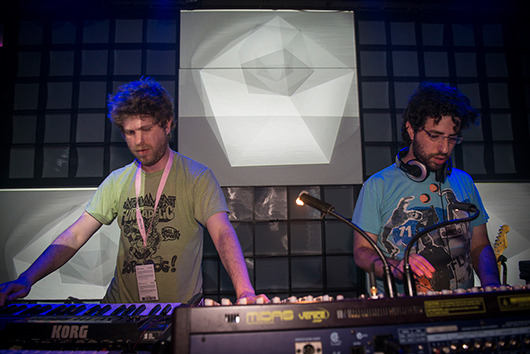
Juju & Jordash closed out the festival in fine fashion.
It’s not often that Juju & Jordash make their way to North America, which made the Amsterdam-based duo’s performance MUTEK a much-anticipated event, even though it kicked off around 2 a.m. on Sunday night. The pair was also tasked with following Moritz Von Oswald and Juan Atkins, who were performing music from their joint Borderland album. That set was intriguing, with the two techno legends slowly developing sedate, bass-heavy techno, but the energy level quickly leapt once Juju & Jordash took the stage. As always, the music was completely improvised, but the duo—which relies extensively on jamming both in the studio and in the live setting—was clearly at ease, assembling one dancefloor-ready rhythm after another and comfortably exploring various facets of the house spectrum. While this approach did mean that there was no particular “track” to listen for or get excited about, the music had a loose, adventurous flair, and actually demanded the audience’s collective attention, as even the best Juju & Jordash grooves were only going to happen for a few moments before disappearing into the ether. After experiencing so many things and hearing so much great music over the past few days, it somehow felt appropriate to end on such an ephemeral note.

